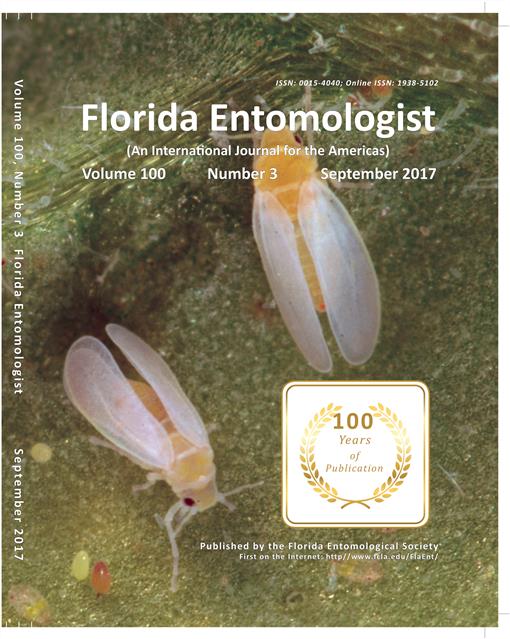Stegasta bosqueella Chambers (Lepidoptera: Gelechiidae) is one of the principal pests of Brazilian peanut crops. Traps made from plastic bottles and baited with molasses sugar can be used to attract S. bosqueella. Molasses-baited traps are a promising tool for the monitoring and control of this insect.
Production of peanuts, Arachis hypogaea L. (Fabaceae), is a traditional agricultural activity in several regions of Brazil, especially in the state of São Paulo, which accounts for 80% of the national production (Santos & Todeschini 2012). The rednecked peanutworm, Stegasta bosqueella Chambers (Lepidoptera: Gelechiidae), is currently considered the most important lepidopteran pest of peanut crops due to the extent of damage and its occurrence in several regions (Boiça Junior et al. 2012). Stegasta bosqueella caterpillars attack shoots when the leaflets are still closed, reducing the leaf area and affecting development of the plant (Almeida 2013).
To control S. bosqueella, pyrethroid and carbamate insecticides are used, which contribute to environmental contamination (Almeida 2013; Scarpellini et al. 2014). As an alternative to chemical control, ethological control is recommended, which is a method based on studies of the physiology and behavior of insects for pest control (Altamar et al. 2016). Ethological control includes techniques such as trapping using attractants and baits, repellents, feeding inhibitors, and other products (Cisneros 1995).
Sugarcane molasses—baited traps are used to monitor several pests, mainly lepidopterans such as Spodoptera exigua Hübner (Lepidoptera: Noctuidae), Helicoverpa species (Lepidoptera: Noctuidae), Chrysodeixis includens Walker (Lepidoptera: Noctuidae), Manduca sexta L. (Lepidoptera: Sphingidae), and Keiferia lycopersicella Walshingham (Lepidoptera: Gelechiidae) (Garza 2002).
Cisneros (2010) confirmed that several noctuid species and some other lepidopterans are attracted by the odor of sugarcane molasses fermentation. Jiménez (2010) also obtained satisfactory results in the capture of Heliothis virescens (F.) (Lepidoptera: Noctuidae) and Mocis sp. (Hübner) (Lepidoptera: Noctuidae) with attractant traps in areas of tobacco seed production in Cuba. In Brazil, traps with sugarcane molasses are used to capture the important fruit fly pests Anastrepha fraterculus (Wiedemann) (Diptera: Tephritidae) and Ceratitis capitata (Wiedemann) (Diptera: Tephritidae) (Raga et al. 2006).
To reduce risks and impacts on human health and the environment caused by the use of pesticides in peanut crops, alternative methods for monitoring and control of the rednecked peanutworm should be explored. Therefore, we sought to evaluate the potential of sugarcane molasses as an attractant food for the capture of S. bosqueella adults in peanut crops.
Evaluations were carried out in an experiment established to compare 2 peanut cultivation systems: intercropped with sorghum, Sorghum bicolor (L.) Moench (Poaceae), and sunflower, Helianthus annuus L. (Asteraceae), and the conventional production system (peanut only). The experiment was conducted in an agricultural area located at the School of Agricultural and Veterinary Sciences, Jaboticabal, São Paulo, Brazil, from Nov 2016 to Feb 2017 (average temperature of 24.2 °C, 75.4% RH, and total annual precipitation of 216.2 mm) and with a record of this insect being present in the area. The intercropping system occupied an area of 0.32 ha of peanut, intercropped with 0.16 ha of sorghum and 0.12 ha of sunflower, whereas the conventional system occupied an area of 0.49 ha. The latter was located 300 m from the intercropping system. The crops were planted on 28 Nov 2016 and the traps installed on 17 Jan 2017.
A total of 10 traps were installed, 5 in each system, using 2 L plastic bottles containing 100 mL of sugarcane molasses per bottle. The bottles had 2 “doors” or “flaps” cut into the sides, allowing entry of the moths. Traps were supported by wood rods at a height of approximately 20 cm from ground level, and sugarcane molasses was replaced twice per mo.
The traps were checked weekly and moths were removed and returned to the laboratory for identification. Voucher specimens were sent to EMBRAPA Cerrados in Brasília, Federal District, Brazil, for confirmation of S. bosqueella and other lepidopterans.
Moths of S. bosqueella (Fig. 1) were captured in traps containing sugarcane molasses in both cropping systems. In total, 310 S. bosqueella adults were captured, representing 60% of total moth capture in the conventional system and 41% of the moths in the intercropped system (Table 1). On average, 7.4 and 1.7 S. bosqueella adults per evaluation period were trapped in the conventional and intercropping systems, respectively.
Adult lepidopterans feed on pollen, nectar, and fermenting fruit juices. Females of several species orient to the host plant by olfactory stimuli and phototaxis, or by the combination of both (Bosa et al. 2011). Lorya et al. (2002) reported that adult Opsiphanes cassina Felder (Lepidoptera: Nymphalidae) females visited traps containing sugarcane molasses looking for sugars and nitrogen compounds that are important for the maturation of their eggs, and Parra et al. (2009) found that sugarcane molasses captured O. cassina adults.
Fig. 1.
Trap containing sugarcane molasses and Stegasta bosqueella adults (see white circles) captured in a peanut crop.

Particularly for the state of São Paulo, the use of traps baited with sugarcane molasses is an economically viable alternative due to the ready availability of the product coming from the sugarcane industry. However, improvements in this technique are needed, including improved formulations, sugarcane molasses preservatives, and optimal distribution of traps in the crop.
Table 1.
Weekly captures of Stegasta bosqueella and other lepidopterans captured by traps in 2 peanut cultivation systems.

We thank Amabílio José Aires de Camargo from EMBRAPA Cerrados, Brasília, Federal District, Brazil, for the confirmation of S. bosqueella and other lepidopterans.





